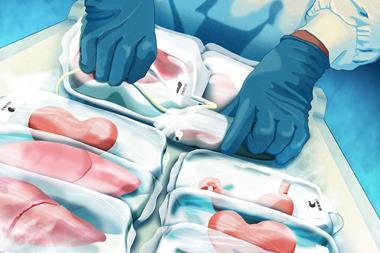The chemical and molecular science communities are invited to participate in a long-term programme to improve innovation and sustainability in Europe. Marian Mours reports
The chemical and molecular science communities are invited to participate in a long-term programme to improve innovation and sustainability in Europe. Marian Mours reports
The European technology platform for sustainable chemistry (SusChem, see box, p54) is leading a pan-continental initiative to boost chemistry and industrial biotechnology research activities and enhance collaborative R&D.
In November 2005 at its third stakeholder meeting, organised by the RSC in London, SusChem stakeholders discussed and endorsed its strategic research agenda (SRA). This proposes a coherent, long-term European chemical research and innovation programme requiring over €5 billion (?3.4 million) per year, keeping in mind that Europe is a world leader in chemicals production (chemicals sales in 2004 were worth €580 billion from the EU-25 countries) and chemistry research.
SusChem’s SRA is the result of eight months of work involving research leaders from industry, universities, European member states and European Commission directorates. The document brings input from SusChem working groups on three critical technology areas (industrial biotechnology, materials technology, and reaction and process design) and cross-cutting issues from its horizontal issues group together with feedback from a consultation exercise undertaken during the summer of 2005 and representations from numerous academic and industrial groups.
The document contains a comprehensive list of research objectives that have been mapped against major societal demands in terms of products and the technologies required to develop them.
To implement the programme, continuous high-level support from both public and private bodies will be needed. The estimated cost of the research programme is €5.5 billion per year. Of this perhaps one-third would need to be found from European and national funds and two-thirds from industry. To put the figure in perspective, current chemical industry R&D spending in Europe is about €10 billion per year.
Materials technology
To develop its SRA contribution the materials technology section has taken a market approach (involving determining the main requirements of society and downstream industries) combined with a technology approach (fundamental knowledge needs and cross-cutting technical issues) to produce a list of innovative products and technologies that will strengthen European competitiveness and improve the wellbeing of its
citizens.
’There will be no sustainable development of our downstream industries without innovative materials,’ says R?diger Iden of BASF and leader of the materials technology section. Nanoscience is a fundamental underlying area of knowledge in this area.

The impact of the materials technology work contributed to two of the three SusChem future scenario projects developed to show the societal impact of SusChem for the SRA: the energy-generating or energy-plus house (see figure) and personalised healthcare.
The energy-plus house contains and demonstrates new materials that deliver very high thermal insulation and novel power production materials including low-cost photovoltaic cladding and self cleaning facades. This leads to surplus energy that can be fed to the power grid.
The healthcare project comprises new materials for implants capable of reconstructing bone or tissue, smart drug delivery, novel therapeutics and diagnostics including personal sensors that can alert both doctor and patient of early signs of illness.
Industrial biotechnology
The main objectives within the industrial biotechnology field are to develop and produce products and processes in a cost- and eco-efficient manner using increasingly renewable raw materials and to discover and optimise new strains and biocatalysts. Colja Laane of DSM and leader of the industrial biotechnology section acknowledges that ’this builds on Europe’s acknowledged strengths: we are number one in enzymes - producing 70 per cent of industrial enzymes at present - and a key player in bio-specialities with excellent infrastructure and a sound knowledge base’.
Seven main research areas have been defined: novel enzymes and microorganisms, microbial genomics and bioinformatics, metabolic engineering and modelling, biocatalyst function and optimisation, biocatalyst design, innovative fermentation science and engineering, and innovative downstream processing. Key R&D themes include: oxidoreductase enzymes as industrial biocatalysts for fine and bulk chemistry, bio-based performance materials and nanocomposite materials (a potential combined activity with the materials technology group); and biomass conversion to fuels.
An integrated, multipurpose biorefinery has been proposed as a visionary potential demonstration project. It would cover biomass supply and conversion technology, bioprocessing and downstream processing technology with application R&D to deliver an array of fuels, bulk and fine chemicals. A parallel study of the societal, economic and environmental impact of the refinery would also take place.
Reaction and process design
Innovation in the reaction and process design area aims to incorporate highly efficient, inherently safe and environmentally benign technologies, tailor-made products with designed properties making efficient use of resources and increasingly flexible, affordable equipment.
Klaus Sommer of Bayer Technology Services and leader of the reaction and process design section believes: ’Reaction and process design is a fundamental enabling technology that can be applied to all areas of chemistry and biotechnology contributing all the way from synthesis to viability of process plants.’ Seven areas along the process chain have been identified for attention: synthetic concepts; catalytic transformations; biotechnological processing; process intensification; in-silico techniques; purification and formulation engineering; and plant control and supply chain management.
As an example, new catalysts would enable different kinds of feedstock to be handled and help attain zero-waste emission processes. Non-conventional energy sources (microwave, light) for synthesis could be tapped and catalysis for health and environmental purposes could be developed. Likewise, process intensification offers a step change in chemical industry plant design in terms of size and safety. Micro-technology could be applied to bulk chemicals and polymers production giving improved process and plant efficiency with respect to space, time, energy, raw materials, safety and the environment.
SusChem
SusChem was jointly initiated by Cefic (the European chemical industry council) and EuropaBio (the European association for bioindustries) in 2004 to help foster and focus European research in chemistry and industrial biotechnology. It is an open multi-stakeholder forum with additional organisational support from GDCh, Dechema, the RSC and ESAB (European Federation of Biotechnology Section of Applied Biocatalysis) and financial support from the European Commission. SusChem foresees a sustainable European chemical industry with enhanced global competitiveness and minimal environmental impact powered by a world-leading, technological innovative drive.
It sees the chemical community as an essential and leading partner in the European knowledge-based economy providing growth and social equity for all its citizens.
Horizontal issues
A strategic approach to innovation should focus on value creation rather than simply looking at cost reduction or environmental performance. SusChem’s horizontal issues group addresses the integration of all the factors underpinning sustainable innovation, from regulatory to economic, environmental and societal. Russel Mills of Dow Europe and leader of the horizontal issues group says: ’Successful integration is a key to our overall industrial sustainability: whether oil below the ground or plants above, chemistry rearranges the molecules to provide the basic building blocks that support our entire supply chain.’
The group’s role is to tackle generic issues that impinge on all three technology areas. There are two main themes: societal concerns and stimulating innovation.
Addressing societal concerns associated with new products and processes will involve promoting dialogue on SusChem technologies, providing stakeholders with information for decision-making and effective open communication of the risk and benefits of new technologies. This will involve a pan-European communication strategy and cooperation with other technology platforms. It will also involve developing research and methodology for risk assessment. In addition, management strategies will need to be developed to support the regulatory framework including the global acceptance of new assessment techniques needed for the production of nanomaterials.
Support for innovation will involve education, skills and capacity building because progress in technology depends on having a pool of young scientists to match the requirements of the SusChem technology areas. Other important issues include leveraging the voice of small and medium sized enterprises in chemical innovation and increasing financial support for start-up companies.
The next step for SusChem is to develop an implementation action plan during 2006. This will be a significant contribution to the European Commission’s seventh framework programme for research, future European framework programmes and other major collaborative European research initiatives. Within the chemical research community SusChem can help to coordinate European, national and regional initiatives, working together with member states, related technology platforms and other organisations.
SusChem also provides an opportunity to improve the public perception of chemistry. The programme shows the chemical sciences and the chemical industry as the drivers of beneficial change for society and finding the solutions to the challenges facing humanity today. Achieving success for SusChem will take commitment and work from dedicated members of the European chemical community in industry, academia and elsewhere. ’SusChem is a unique opportunity for the chemical community in Europe to demonstrate and grow its strengths and contributions to society,’ says Alfred Oberholz, member of the board of management of Degussa, who took over as chairman of the SusChem board from Emmo Meijer after the London meeting.
Marian Mours is innovation manager, Cefic
RSC and GDCh cooperate
As part of the RSC and the German chemical society’s (GDCh) collaborative work, Chemistry World and Nachrichten aus der Chemie are publishing a series of articles simultaneously in both magazines. This article continues the series.

Further information
- 4th SusChem stakeholder workshop, Budapest, 27 August 2006, to coincide with the 1st European Chemistry Congress






No comments yet